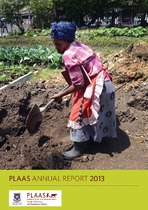| dc.description.abstract | This Act is most commonly associated with the consolidation of the colonial ‘land grab’, which had gathered force during the previous 200 years, and with helping to create the framework for the infamous ‘Black Spot dispossessions’ of the Apartheid regime. But the Natives Land Act was about much more than land. Most importantly it played a key role in territorially and politically entrenching racial segregation into the very political structure of South African society, relegating the majority of its population into ‘reserves’ and ‘homelands’ under the
control of undemocratically appointed and imposed chiefs and puppet rulers.
A century later, the legacy of this Act still shapes the lives of South Africans, in town as well as in the countryside. The inequitable distribution of land continues to plague the present-day agro-food system, so that millions spend their lives in poverty while only a small number of powerful agri-businesses and individuals benefit. The glaring racial inequality in land ownership – and the inability of nearly 20 years of land reform to do much about it – continues to be a politically toxic legacy for the country as a whole, and threatens to undermine the project of national reconciliation. Even more crucially, the colonial land grab and its Apartheid-era consolidation has brought about an enormous level of inequality in wealth and income in the economy as a whole. | en_US |

